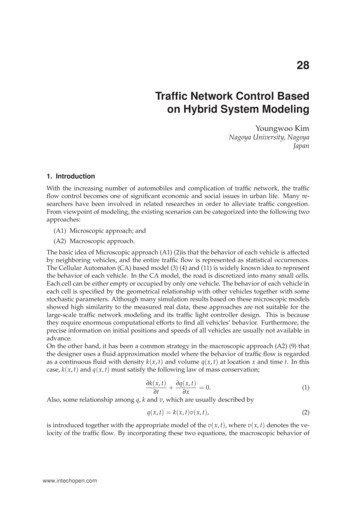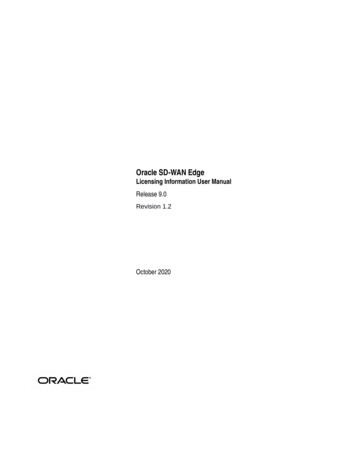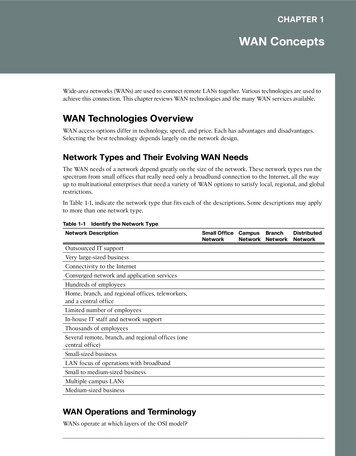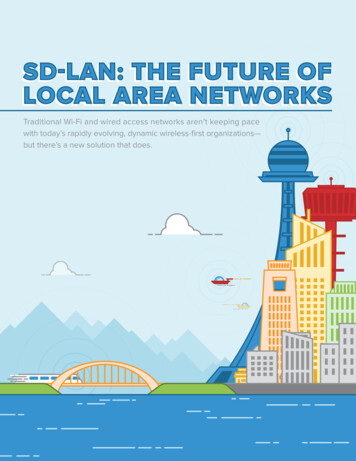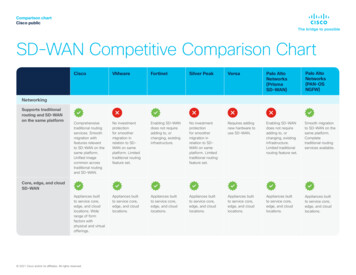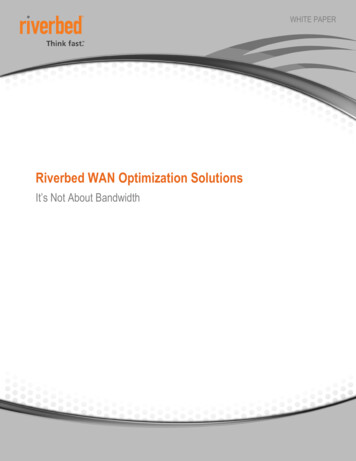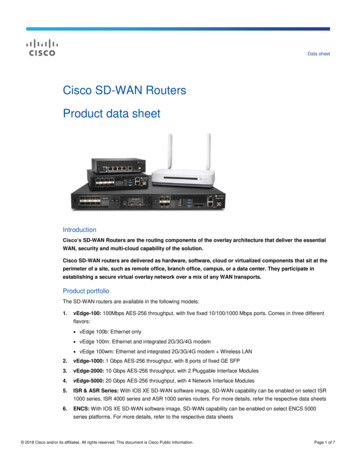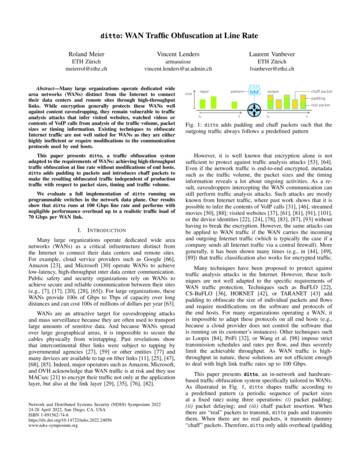
Transcription
ditto:WAN Traffic Obfuscation at Line RateRoland MeierVincent LendersLaurent VanbeverETH r.admin.chETH Zürichlvanbever@ethz.chAbstract—Many large organizations operate dedicated widearea networks (WANs) distinct from the Internet to connecttheir data centers and remote sites through high-throughputlinks. While encryption generally protects these WANs wellagainst content eavesdropping, they remain vulnerable to trafficanalysis attacks that infer visited websites, watched videos orcontents of VoIP calls from analysis of the traffic volume, packetsizes or timing information. Existing techniques to obfuscateInternet traffic are not well suited for WANs as they are eitherhighly inefficient or require modifications to the communicationprotocols used by end hosts.This paper presents ditto, a traffic obfuscation systemadapted to the requirements of WANs: achieving high-throughputtraffic obfuscation at line rate without modifications of end hosts.ditto adds padding to packets and introduces chaff packets tomake the resulting obfuscated traffic independent of productiontraffic with respect to packet sizes, timing and traffic volume.We evaluate a full implementation of ditto running onprogrammable switches in the network data plane. Our resultsshow that ditto runs at 100 Gbps line rate and performs withnegligible performance overhead up to a realistic traffic load of70 Gbps per WAN link.I.I NTRODUCTIONMany large organizations operate dedicated wide areanetworks (WANs) as a critical infrastructure distinct fromthe Internet to connect their data centers and remote sites.For example, cloud service providers such as Google [66],Amazon [23], and Microsoft [30] operate WANs to achievelow-latency, high-throughput inter data center communication.Public safety and security organizations rely on WANs toachieve secure and reliable communication between their sites(e.g., [7], [17], [20], [28], [65]). For large organizations, theseWANs provide 100s of Gbps to Tbps of capacity over longdistances and can cost 100s of millions of dollars per year [63].WANs are an attractive target for eavesdropping attacksand mass surveillance because they are often used to transportlarge amounts of sensitive data. And because WANs spreadover large geographical areas, it is impossible to secure thecables physically from wiretapping. Past revelations showthat intercontinental fiber links were subject to tapping bygovernmental agencies [27], [59] or other entities [77] andmany devices are available to tap on fiber links [11], [25], [47],[68], [85]. Indeed, major operators such as Amazon, Microsoft,and OVH acknowledge that WAN traffic is at risk and they useMACsec [21] to encrypt their traffic not only at the applicationlayer, but also at the link layer [29], [35], [76], [82].Network and Distributed Systems Security (NDSS) Symposium 202224-28 April 2022, San Diego, CA, USAISBN utputchaff packetpaddingreal packett0tt0tFig. 1: ditto adds padding and chaff packets such that theoutgoing traffic always follows a predefined patternHowever, it is well known that encryption alone is notsufficient to protect against traffic analysis attacks [53], [64].Even if the network traffic is end-to-end encrypted, metadatasuch as the traffic volume, the packet sizes and the timinginformation reveals a lot about ongoing activities. As a result, eavesdroppers intercepting the WAN communication canstill perform traffic analysis attacks. Such attacks are mostlyknown from Internet traffic, where past work shows that it ispossible to infer the contents of VoIP calls [31], [46], streamedmovies [50], [88]; visited websites [37], [61], [81], [91], [101],or the device identities [22], [24], [78], [83], [87], [93] withouthaving to break the encryption. However, the same attacks canbe applied to WAN traffic if the WAN carries the incomingand outgoing Internet traffic (which is typically the case if acompany sends all Internet traffic via a central firewall). Moregenerally, it has been shown many times (e.g., in [44], [49],[89]) that traffic classification also works for encrypted traffic.Many techniques have been proposed to protect againsttraffic analysis attacks in the Internet. However, these techniques are not well adapted to the specific requirements ofWAN traffic protection. Techniques such as BuFLO [22],CS-BuFLO [36], HORNET [42], or TARANET [43] addpadding to obfuscate the size of individual packets and flowsand require modifications on the software and protocols ofthe end hosts. For many organizations operating a WAN, itis impossible to adapt these protocols on all end hosts (e.g.,because a cloud provider does not control the software thatis running on its customer’s instances). Other techniques suchas Loopix [84], PriFi [32], or Wang et al. [98] impose stricttransmission schedules and rates per flow, and thus severelylimit the achievable throughput. As WAN traffic is highthroughput in nature, these solutions are not efficient enoughto deal with high link traffic rates up to 100 Gbps.This paper presents ditto, an in-network and hardwarebased traffic obfuscation system specifically tailored to WANs.As illustrated in Fig. 1, ditto shapes traffic according toa predefined pattern (a periodic sequence of packet sizesat a fixed rate) using three operations: (i) packet padding;(ii) packet delaying; and (iii) chaff packet insertion. Whenthere are “real” packets to transmit, ditto pads and transmitsthem. When there are no real packets, it transmits dummy“chaff” packets. Therefore, ditto only adds overhead (padding
or chaff packets) in a way that does not degrade the networkperformance for the real traffic. It fills the gaps when thereis not enough real traffic to transmit and (slightly) delaysreal packets in order to make the resulting network behaviorindependent of the actual traffic being sent.dittoswitchLANLANWANLANLANruns on the gateway network devices (e.g., routersor switches) of the WAN sites and does not require any modification to the end hosts or protocols. Being network-based,it is further efficient and supports high-speed obfuscation evenwhen the traffic is bursty and unpredictable. ditto devicescan react locally to traffic changes in real time. This allowsthem to quickly adapt to different network loads and to add orremove chaff packets almost instantly depending on the actuallink load. In contrast, application-based approaches that run onthe end hosts lack the visibility of the network load and needto send chaff traffic independent of other applications, whichcreates a significant overhead that ditto does not have.dittoprotected linkFig. 2: Network model. ditto protects WAN links whichinterconnect different sites of an organization.II.M ODELIn this section, we describe the network model (§II-A), theattacker model (§II-B), and ditto’s security goals (§II-C).A. Network modelWe implemented ditto using off-the-shelf programmablenetwork hardware of the same type as major operators havealready deployed [3], [4]. We show that ditto can obfuscatepacket size, timing and volume information at line-rate. Inthe evaluation, we run interactive applications over ditto andwe show that a ditto-enabled device can obfuscate up to70 Gbps of production traffic (on a 100 Gbps link) withoutany significant impact on the network performance (in terms ofthroughput, packet loss, latency and jitter). This performance isenough for typical WANs since they usually run at (much) lessthan 60 % utilization [17], [28], [66]. Even in highly optimizedWANs such as the ones of Google and Microsoft where theutilization is close to 100 % [63], [66], ditto could protect allthe non-background traffic (which accounts to less than 50 %[63]). We further show that the efficient patterns computed byditto result in a significant performance increase compared tosimpler approaches in previous work while not compromisingsecurity properties against traffic analysis attacks.We consider a wide area network (WAN) which connectsmultiple sites of one organization over dedicated, encryptedtunnels as illustrated in Fig. 2. These tunnels can be created atlayer 2 (e.g., leased fibers and MACsec encryption) or at layer3 (e.g., IPsec tunnels). Each tunnel has a guaranteed bandwidthwhich the organization can fully utilize.Each site is connected to the WAN with a programmableswitch. These switches act as gateways between the local areanetwork (LAN) in each site and the link(s) which interconnectthe sites. The operator has full control over these switches andthe LANs, but it does not control the WAN tunnels.We note that such programmable switches are widelyavailable already and being deployed in large-scale infrastructure including AT&T, Deutsche Telekom, and Alibaba [3], [4].B. Attacker modelOur main contributions are:We assume that the attacker has access to all devices andlinks in the WAN, but she does not have access to devices orlinks inside the LANs of the operator (including the gatewayswhere ditto is running). The attacker can record timestampsand packet sizes but she cannot access the contents of packetssince they are encrypted. We assume that the encryptionhappens at the same layer as the tunnel (e.g., MACsec [21]for a layer-2 tunnel, or IPsec [14] for a layer-3 tunnel). Theattacker can also inject, modify, delay, or drop packets. a strategy to determine packet sizes that allow an efficientmixing of real and chaff packets (§V); an architecture to obfuscate the traffic volume and timingat line rate in network switches (§VI); a full implementation (available as open source1 ) on offthe-shelf hardware (§VIII); and an evaluation on real Internet traffic and with interactiveapplications (§IX).Our attacker model is realistic for typical organizations. Aswe elaborated in §I, several such wiretapping attacks happenedin the past [27], [77] and major operators deploy link-layerencryption to mitigate them [29], [35], [76], [82].The remainder of this paper is organized as follows. In§II, we describe the network and attacker models as well asthe security goals. In §III we summarize the key conceptsof programmable network devices. In §IV, we provide anoverview over ditto before we describe its main componentsin more detail (pattern computation in §V and traffic shapingin §VI). In §VII, we discuss ditto’s security properties andlimitations. In §VIII we describe the hardware implementationand in §IX we evaluate it. Finally, we review related work in§X and conclude in §XI.C. Security goalsSimilar to related work [43], [84], ditto shapes networktraffic such that it satisfies the following security goals: Volume anonymity: The attacker cannot determine thereal size of individual packets and flows which are sentover the WAN. This prevents attacks such as the onepresented by Boshart and Rossow [34].1 https://github.com/nsg- ethz/ditto2
Timing anonymity: The attacker cannot determine thetiming between packets composing real traffic. This prevents attacks such as the ones presented by Wang et al.[99] and Feghhi and Leith [54]. Path anonymity: The attacker cannot track packets acrossWAN tunnels. This prevents attacks such as the onepresented by Wang et al. [99].IV.In this section, we explain the high-level concepts behindusing a running example and Fig. 3.dittoDesign goals The high-level goals of ditto are (i) to makethe WAN traffic that an eavesdropper receives independent (interms of packet sizes, inter-packet time and traffic volume)from the actual traffic that is exchanged over the network;(ii) to support high-throughput networks without degradingtheir performance; and (iii) to operate without requiringchanges to end-devices (e.g., clients or servers).The key enabler for ditto to achieve these goals at line rateis that ditto operates in the network (on routers or switches)and not on end devices such as clients or servers. In thefollowing section, we describe this deployment scenario.III.ditto OVERVIEWBACKGROUND ON PROGRAMMABLE SWITCHESWorkflow ditto reaches these goals by running on programmable network devices (no changes to end-devices) andby shaping the incoming WAN traffic into a repeating sequenceof packets with pre-defined sizes and timing. With ditto, thetraffic actually flowing through the WAN is therefore perfectlyindependent from the real traffic entering it. A ditto-enabledswitch shapes traffic by (possibly): (i) padding incoming packets, to regularize their sizes; (ii) buffering/delaying incomingpackets, to regularize their timings and their relative order;and (iii) inserting chaff packets, to fill any possible gaps andensure the consistency of the packet rates. Of course, enlargingpackets and/or delaying them comes at a cost. ditto reducesthis overhead by optimizing the shaping pattern.We base our design on programmable switches, as specifiedby the Portable Switch Architecture (PSA) [10] because thesedevices provide both high performance and the flexibilitywhich we need to implement ditto. Such switches allowrunning custom programs (implemented in P4 [33]) in thedata plane and can process traffic at terabits per second [8].Programmable switches have been used for many securityapplications before [56], [69], including various types ofobfuscation techniques [72], [74], [75], [94].The PSA specifies five building blocks which each packettraverses: parser, ingress pipeline, traffic manager, egresspipeline, and deparser. Below, we provide more details abouteach of these building blocks.In the paragraphs below, we rely on a simple example andFig. 3 to explain how ditto determines the “shape” of thepacket stream (we refer to this as the obfuscation pattern) andhow ditto modifies traffic such that it follows this pattern.The parser receives the incoming packet and extractsheaders. The format of these headers is programmable (i.e.,the parser can extract custom header formats). Only the parsedparts of the packet are accessible in the pipelines. The rest ofthe packet is considered as payload and cannot be modified.Architecture ditto has two components: (i) a pattern computation algorithm to compute a secure and efficient trafficpattern based on the packet size distribution; and (ii) a dataplane program to shape traffic according to this pattern at linerate by padding packets and introducing chaff packets.The ingress pipeline receives the packet’s headers togetherwith metadata (e.g., its ingress port), which is all stored in thepacket header vector (PHV). The pipeline consists of severalstages in which match & action tables can match on data inthe PHV and trigger actions to modify it.Simple example We consider a simplistic WAN composedof two ditto switches connected by one link. In this WAN,packets are of three sizes: 25 % of the packets are 500 B, 25 %are 1000 B and 50 % are 1500 B. The ordering of the packetsfollows an unknown distribution.The architecture and the focus on processing packets at linerate imposes three main limitations concerning the ingress (andegress) pipeline: (i) the number of pipeline stages limits thenumber of sequential actions that can be performed on eachpacket; (ii) the size of the PHV limits the size of the parsedheaders and metadata (which can be seen as local variables);and (iii) operations which take a non-constant time per packetare not possible (e.g., loops, splitting or merging packets).Pattern computation Given the packet size distribution asan input, ditto first computes an efficient obfuscation pattern.The obfuscation pattern specifies the order and sizes of packetstraversing a link protected by ditto. We define it as an orderedlist of packet sizes (the pattern states). ditto then repeats thispattern infinitely. For example, if the pattern is [500,1000],ditto shapes the incoming traffic such that the outgoing packetsizes are [500,1000,500,1000,500,1000,.] at a fixed rate.The Traffic Manager (TM) switches packets from ingressto egress pipelines. If needed, the TM buffers packets in first-infirst-out (FIFO) queues. When the egress pipeline can processthe next packet, the TM selects a queue and sends its nextpacket to the egress pipeline. To determine the queue, theTM can use different strategies [90]: (i) the queue’s priorities;(ii) weighted round-robin; (iii) a combination of both (roundrobin among queues with equal priorities).An efficient pattern minimizes the overhead in terms ofpadding (bytes added to a packet to make it larger) and chaffpackets (dummy packets inserted to transmit at a constantrate). To minimize the amount of required padding, dittocomputes the pattern such that it allows to distribute packetsuniformly over all pattern states (this leads to minimal paddingon average). To minimize chaff packets, ditto prefers shortpatterns (this reduces gaps between real packets). In §IX, weshow that patterns of length 3 to 6 achieve good results.The egress pipeline is identical to the ingress pipelineexcept that it is attached to an egress port. As a consequence,it is for example no longer possible to change a packet’s egressport once the packet has passed the TM. Similarly, the deparseris the inverse of the parser: It takes the headers and the payloadand assembles the final packet.3
Efficient patterncomputation (§IV)PatternOverhead[1500]50 %25 %[1000, 1500]1500 B500 B1000 B0[500, 1000, 1500][500, 1000, 1500, 1500]packet sizedistributionTraffic shaping inthe data plane (§V)pattern computationditto switchparseringress pipelinetraffic managerq0,cq1,cq0 q1q2,rq2,crealpacketdecryptq2 q3q3,rqueueselectionq3,c5001000add dtraffic priorityqueueschaffpacketdeparser q1,runprotectedtrafficegress pipelineq0,rsizeround robinschedulingchaffpacketclonerecirculationFig. 3: ditto overview. The combination of priority queueing (real packets have higher priority and there is always a chaffpacket ready to send with lower priority) and round-robin scheduling (one queue per pattern state) ensures that the outgoingtraffic follows the predefined pattern regarding packet sizes and timing. The figure does not show the removal of padding on theother end of a protected link.In the example from above, possible patterns include theones listed below. For assigning packets to a pattern state, theobjective is to minimize the amount of padding. Therefore,each packet is assigned to the next larger pattern state.When a packet arrives at a ditto switch, ditto first assignsit to a pattern state. A pattern state is one entry in the pattern;it defines the size which the packet has when it leaves theswitch. Since ditto cannot split packets, it assigns a packetto the next-larger pattern state.2 For example, a packet of size800 B is assigned to the pattern state 1000 (P1 in Fig. 3) suchthat ditto sends it next time it needs to send a 1000 B packet. [1500]: This would require to add 1000 B padding to25 % of the packets (the ones of original size 500 B)and 500 B to another 25 % of the packets (the ones of1000 B). But it minimizes the number of chaff packetssince all packets can be padded to this size. [1000,1500]: Here, the 1500 B packets can be sent in the1500 B state and the other packets in the 1000 B state.Therefore, ditto only needs to add 500 B of paddingto 25 % of the packets. However, it needs to send chaffpackets if multiple 1500 B packets arrive subsequently. [500,1000,1500,1500]: Here, the pattern equals the input distribution and ditto can send each packet withoutpadding. However, it might need to send chaff packetsdepending on the order in which the real packets arrive.Each pattern state Pi has two first-in-first-out (FIFO)queues with priorities. A high-priority queue to which dittoassigns real packets (qi,r ) and a low-priority queue whichditto fills with chaff packets (qi,c ).In the example, ditto assigns the 800 B packet to thehigh-priority queue q1,r belonging to the pattern state P1 .Filling the low-priority queues with chaff packets requiresa way to generate these packets. ditto achieves this by continuously recirculating chaff packets and cloning them into thelow-priority queues. This does not require a dedicated trafficgenerator and it does not affect the switch performance (exceptthat it requires one switch port to perform the recirculation).For the continuation of the example, we use the pattern[500,1000,1500,1500].ditto then feeds the output of each pair of priority queues(qi,r , qi,c ) to a round-robin queue qi and it configures theirrates such that the output is 1/L-th of the total rate (fora pattern of length L). As a result, each pair of priorityqueues will output packets at a constant rate and irrespectiveTraffic shaping The data-plane component of ditto mergesincoming real packets with chaff packets such that the mixfits the pattern with minimal overhead. This is challengingbecause it needs to be performed in hardware to achieve highperformance but typical networking hardware is not designedfor this. ditto solves this challenges by combining switchqueuing and scheduling to hierarchical queues with 2 levels:2 Fragmentation is often not available on switches or routers for performancereasons. The largest pattern state needs to correspond to the maximum sizeof any packet in the network (MTU). If multiple states have the same size,ditto distributes packets uniformly among them.4
Selecting the pattern states Since ditto iterates over thepattern and sends the same number of packets from each ofthe states over time, we compute the pattern such that eachpattern state fits for 100L % of the packets. This is the case ifthe pattern state Pi is equal to the ((i 1)·100/L)-th percentileof the expected traffic distribution D:of whether there is a real packet or not (since there is alwaysat least one chaff packet in each low-priority queue).In the next phase, ditto performs round-robin schedulingamong the round-robin queues (q0 , q1 , q2 and q3 in Fig. 3).Because the order of the round-robin queues corresponds tothe obfuscation pattern, the scheduler then outputs packetsaccording to the pattern.Pi percentile(i 1)·100/L DAfter the queuing and scheduling in the traffic manager,pads the packets in the egress pipeline. At this point,the ordering of the packets is already following the pattern andeach packet is marked with its target size. ditto adds paddingheaders to compensate for the difference between the actualpacket size and the target size. For example, it adds 200 B ofpadding headers for the 800 B packet from above.ditto(2)When to compute and update the pattern D models thedistribution of real packet sizes expected on the protected link.Ideally, the operator computes it based on the real traffic (e.g.,recorded prior to using ditto). Since this distribution onlyreveals information about the average traffic characteristics, itis usually not confidential. Otherwise, the operator can usepublicly available data such as [38].Now that the packet has the right size, ditto sends it tothe egress port. There, the packet needs to be encrypted (e.g.,using MACsec, which can run at line rate [62]) before it leavesthe switch. The encryption ensures that an attacker cannot seethe padding and she cannot distinguish between real and chaffpackets from content analysis.V.i [0, 1, . . . , L 1]When D changes significantly, the operator can computea new pattern and reconfigure ditto to use the new patternwithout interruption. However, as we show in the evaluation(§IX), the same pattern can be used for many months of realInternet traffic with almost constant overhead.C OMPUTING EFFICIENT TRAFFIC PATTERNSVI.A naive pattern would be to make all packets equal size.However, this would be inefficient because network trafficcontains a variety of different packet sizes and ditto wouldneed to pad them all to the maximum size. For example,Internet backbone traffic is bi-modal (most packets are of size 70 B or 1400 B) [39].In this section, we explain how ditto shapes traffic suchthat it follows the previously defined pattern.Problem A switch running ditto receives packets withunpredictable size and at unpredictable times and it needsto ensure that the packets that leave the switch follow thepredefined pattern (w.r.t. to packet sizes and inter-packet time).To achieve this, ditto needs to perform three operations usingthe capabilities of programmable switches: (i) add padding toreal packets; (ii) buffer packets until they fit in the pattern; and(iii) insert chaff packets.In this section, we describe how ditto computes efficientpatterns by minimizing the overhead for the expected traffic.Definition An obfuscation pattern P for ditto is an orderedlist of length L which specifies sizes of packets Pi :P [P0 , P1 , . . . , PL 1 ],Pi NT RAFFIC SHAPING IN THE DATA PLANE(1)Architecture The architecture of a ditto switch is as follows(cf. illustration in Fig. 3). When a real packet arrives at theditto switch, the parser first extracts information such as theIP header. Then, ditto determines the egress port dependingon the packet’s destination address and assigns it to one ofthe queues which belong to this egress port. For a pattern oflength L, each egress port (these are the ports where obfuscatedtraffic leaves a ditto switch) has L queues and each queuecorresponds to one state in the pattern (and therefore onepacket size). The traffic manager then performs round-robinscheduling to send packets from the queues to the egresspipeline. There, ditto adds padding such that the packet’s sizeeventually matches the target size determined by the pattern.Finally, the packet exits at the egress port.Given such a pattern for a link protected by ditto, dittoorders and pads packets such that their size follows P . Thatis, the j th packet is of size Pj mod L .Every pattern is secure We first note that ditto achieves itssecurity goals with every pattern because the pattern is staticand therefore does not reveal information about the real traffictraversing a protected link.Efficient patterns Obfuscation patterns differ in their overhead. Intuitively, a pattern is more efficient than another if itrequires less padding and buffers/reorders real packets less. Inthe following paragraphs, we explain how we determine thepattern length L and its states Pi to obtain efficient patterns.Unfortunately, typical round-robin scheduling has a property that is not optimal for ditto: It skips a queue if it doesnot contain a packet. This is problematic for ditto becauseit leads to skipped states in the pattern. To avoid this, dittomakes sure that there is always at least one packet in eachqueue. If there is no “real” packet available, the switch sendsa “chaff” packet.Selecting the pattern length The pattern length impacts theamount of: (i) padding required, longer patterns require lesspadding as they can better fit the original traffic distribution;(ii) chaff packets generated, shorter patterns generate lesschaff packets because incoming packets are spread over fewerstates; and (iii) packet reordering, longer patterns lead to morereordered packets because they require more queues.Assigning packets to queues ditto selects the queue to whichit assigns a packet such that the amount of padding is minimal.In §IX, we show empirically that patterns of length 3–6achieve good results in all dimensions and for realistic traffic.5
VII.Since ditto can only make packets larger, it selects the nextlargest queue i for a packet of size s and pattern states Pi :i arg min(Pi s s Pi )iS ECURITY ANALYSIS AND LIMITATIONSIn this section, we explain why ditto achieves the securitygoals from §II-C and we discuss ditto’s limitations.(3)A. Security goalsIf the packet fits into more than one state with the same amountof padding, ditto randomly selects one of them.Volume anonymity The obfuscation pattern together with thelink bandwidth defines the traffic volume (in terms of bytesand packets) that is transmitted over every protected link. Sincethis volume is static and independent from the real traffic, anattacker cannot learn anything from it other than the maximumnumber of bytes and packets sent over the link if the link wasfully utilized. Naturally, an attacker with access to multiplelinks and additional background information can derive anupper bound for the total traffic volume (cf. §VII-B).Round-robin scheduling to implement the pattern dittoconfigures all queues of an egress port with the same prioritysuch that the traffic manager (TM) performs round-robinscheduling. The TM therefore iterates over all queues andsends one packet from each non-empty queue.The main challenge to ensure that the sent packets alwaysfollow the pattern is therefore to make sure that a queue isnever empty when the TM tries to send a packet from it.Ideally, the hardware would allow to inject a “chaff” packetwhen the TM attempts to send a packet from an empty queue.While this would be a small extension in hardware, there wasno need for such a feature so far and thus it does not exist.Below, we describe how we combine priority queueing andround-robin scheduling to overcome this limitation.Timing anonymity Because ditto always sends traffic according to the same pattern and at the same rate, it does notleak timing information. Since packets are encrypted such thatthe ciphertext changes for each WAN link, attackers cannotdistinguish real and chaff packets and they cannot determinewhich packets belong to the same host, application or flow.Path anonymity Even if an attacker can eavesdrop on alllinks connected to a ditto switch, she cannot link incomingand outgoing packets because (i) the pattern of incomingand outgoing packets is always the same and ditto wouldrather drop packet than violate the pattern; (ii) she does notknow which packets contain real traffic; and (iii) packets areencrypted such that the ciphertext changes for every WAN link.Priority queuing to mix real and chaff packets To ensurethat round-robin queues ar
low-latency, high-throughput inter data center communication. . VoIP RTT 0 20 40 60 80 100 Input rate [Gbps] 0 Load time [s] 2 Top9 webpage load time l 1 with ditto l 3 with ditto l 6 with ditto l 1 baseline l 3 baseline l 6 baseline (b) CAIDA Fig. 7: ditto compared to the baseline. Lines show mean
